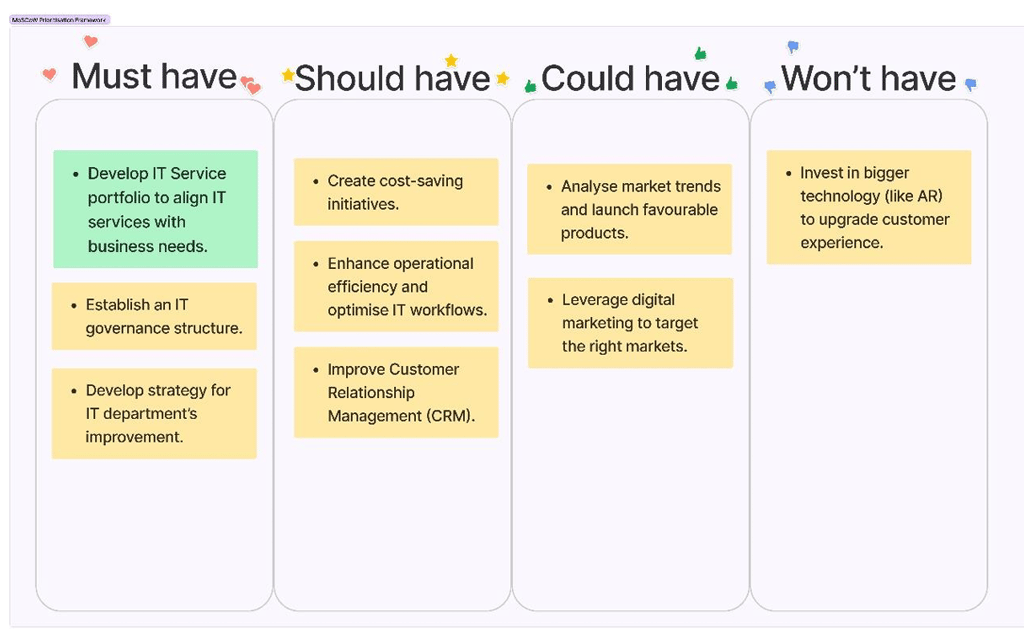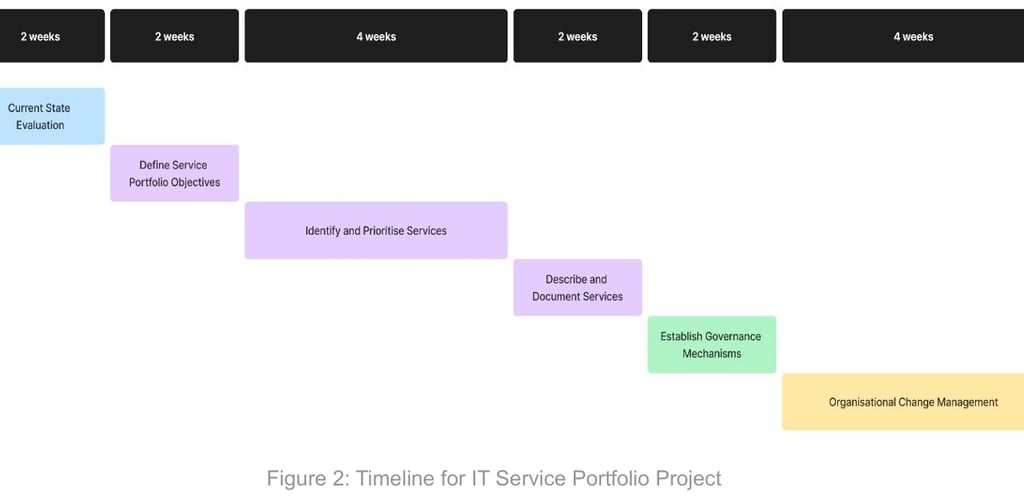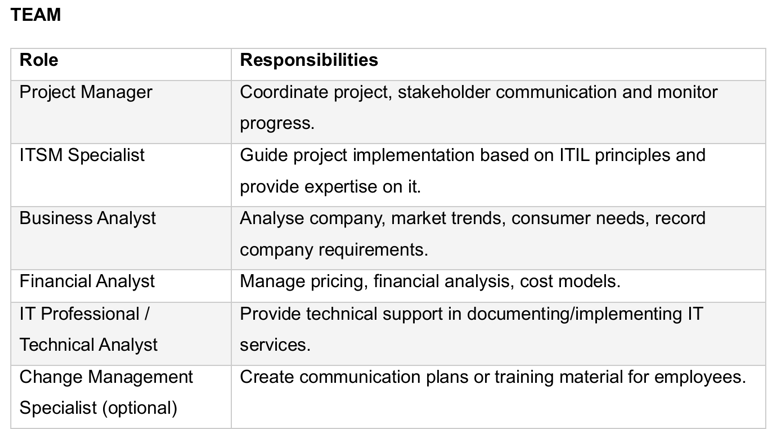ITIL based ITSM Consulting Case Study
Designing an IT Service Portfolio Management strategy using ITIL framework for a retail case company to align its IT services with business goals. Gives a quick introduction to the ITIL framework, and suggests an ML application proposal for the retail case company addressing its growth.

Consulting Case Summary:
Requirement: To propose an IT Service Management (ITSM) consulting project to address a key IT issue at a retail company XYZ and introduce a machine learning approach to analyze public sentiment on a certain clothing item for a potential product launch.
With digital transformation leading the way for organisations and IT services being an inevitable part of traditional companies as well, IT Service Management (ITSM) frameworks have garnered significant attention in recent years. These frameworks emphasise best practices across the organisation to manage the complex IT environment, ensure its alignment with business goals, and its continuous improvement focusing on delivering maximum value to the customer while maintaining service quality. This project puts forth a consulting proposal suggesting a solution incorporating a key aspect of the IT Strategy phase of ITIL framework, and a machine learning technique to analyse public opinion on a forthcoming product.
Information Technology Infrastructure Library (ITIL)
The retail company XYZ had a lack of standardised processes for IT Service Management.
According to IBM, ITIL is seen as the leading framework for implementing and documenting ITSM. This ‘best practices’ framework can help abridge the visible lack of alignment between the company’s goals and IT strategy. It has five stages that can be implemented and revisited as required:
Service Strategy: Digital transformation should not be exclusively for the IT departments since this would result in a separate subunit that may not necessarily align with the route taken by the company. Hence, XYZ must focus on creating a proper IT Strategy tailored towards its business goals and have a functional IT structure for effective management. This stage covers aspects such as service portfolio management, strategy management, financial management, demand and business relationship management for IT services (IBM, 2023a).
Service Design: This stage involves designing the services, technology and architecture in an optimised way to meet customer expectations, and clearly defines tools, management systems and mechanisms needed to measure their effectiveness (Fathelrahamn, 2020).
Service Transition: In this stage, IT services are built and deployed. It facilitates other aspects like change management, service asset and configuration management, release and deployment management, knowledge management and so on.
Service Operation: The service operation stage focuses on delivering the service consistently, managing any disruptions, determining the root causes and trends dealing with repetitive issues and its overall well-being (Fathelrahamn, 2020).
Continual Service Improvement: This phase focuses on continuous improvement of the quality of IT services and infrastructure using quality management methods to analyse previous performances and using the inferred information to improve (Coursera, 2023).
CONSULTING PROPOSAL
CLIENT'S SITUATION
An analysis of XYZ indicated that its IT department showed a lack of satisfactory performance despite major investments, demonstrating a discrepancy between the company’s business goals and IT Strategy. The procurement of IT products based on ‘needs of the employees’ indicated the absence of a well-defined IT management structure. Hence, the company must provide better visibility of the shape of its IT department. Additionally, to reduce costs and optimise productivity, they can increase operational efficiency. They can also thrive in a competitive environment, by understanding market trends to correctly identify customer preferences and catering to it.
XYZ had immense growth opportunities and with a solid online presence, they could serve multiple markets. This could be achieved by harnessing the power of data gathered online and using data-driven decision-making to predict customer demands and enhancing customer experience with digital channels of communication (like CRMs). Li & Fung, a supply chain management company used virtual design technology to reduce development time by 50% increasing operational efficiency (Tabrizi et al., 2019).
The following demonstrates how the MoSCoW prioritisation framework is applied on potential problems that can be addressed:
Prioritising based on the current company needs, I recommend developing an IT service portfolio to evaluate services currently offered and gain insights about what might be needed in the future.
How does this map to IT SERVICE PORTFOLIO MANAGEMENT?
(1) Current State Evaluation:
Conduct research through interviews with internal stakeholders or teams under concern, analysing all available service documentation and creating a combined repository of this information. This can help identify gaps and obstacles in the current service portfolio. A thorough evaluation of alignment of the current company goals and the existing services can assess the need of each existing service.
(2) Define Service Portfolio Objectives:
Define clear objectives for the IT Service portfolio through stakeholder discussions. It is best to create the structure for the portfolio on analysing market trends and predicting customer demand for services, since this would help identify the right services to include. Identify key metrics to evaluate the performance and relevance of each service to be introduced.
(3) Identify and prioritise the services:
After defining portfolio objectives, different service components have to be created and structured into different packages (Serifovski & Skytte, 2016). Ask members of all teams in a company to identify all the services they require internally, and add it to the list of services required by the customers, categorising it to appropriate packages, like Customer Support, Identity Management Services etc.
In ITIL Service Portfolio Management, services are in one of the three stages:
(i) Service Pipeline: New services that provider intends to offer.
(ii) Service Catalogue: Services currently offered.
(iii) Retired Services Catalogue: Archived services no longer in deployment.
Add the right services to the pipeline and set criteria to retire or archive services not required anymore.
(4) Describe and Document the Services:
Document every IT service in the portfolio including service descriptions, features, advantages and any service level agreements (SLAs) associated. Redesign a separate service catalogue with concise descriptions for customers and detailed operational structure and guidelines for all services internal to the company for internal stakeholders. Additionally, include information on a strategic and operational level with information regarding pricing models and costs (Serifovski & Skytte, 2016).
(5) Service Review and Governance Mechanisms:
Establish a governance structure to control the maintenance of the IT Service Portfolio. Assign responsibilities for updating service information and reviewing performance based on predefined metrics. To thrive in dynamic business environments, XYZ must regularly assess the value of services and their alignment with the company objectives.
(6) Organisational change management (Optional for now):
The changes must be communicated to all employees to ensure a unanimous understanding of specific ITIL terms or new processes. This can be taken up as a follow-up task, or as an extension of the current task. Change Managers can train employees to facilitate smooth adoption of these processes, minimise resistance and provide support.
SCHEDULE AND TEAM
CHALLENGES
A major challenge is deciding the specific services to invest in, when there are limited resources. Based on ITIL guidelines, ‘value’ of a service refers to how it improves business outcomes and performance of company’s assets (Oliveira et al., 2010). Hence, XYZ can consider enhancing IT Service Portfolio Management of ITIL with appropriate prioritisation. Other challenges include resistance to change and improper understanding of portfolio services. These can be addressed by implementing a change management programme that educates employees and provides support.
BENEFITS
IT Service Portfolio Management would give increased transparency on spending. IT spending can be prioritised based on business needs, eliminating any unnecessary or redundant service thereby improving the IT service delivery value while ensuring alignment with the company’s strategic goals. Having a holistic view of the IT services and goals will improve communication and result in better decision-making. With appropriate review mechanisms, the performance of the services can be monitored, delivering better value to consumers, making IT an aid to improve business value than just an additional cost (ServiceNow, 2023).
MACHINE LEARNING APPLICATION PROPOSAL
MACHINE LEARNING METHOD AND INTRODUCTION
XYZ has access to publicly available product feedback through e-commerce platforms, social media mentions, and customer reviews. However, internal structured customer sentiment databases or advanced tagging mechanisms are limited. Data governance practices are minimal, with ad hoc data cleaning and labeling processes, often manual. Advanced analytics or AI/ML capabilities are currently outsourced or being piloted through consultants. The organization uses on-premises systems and its current infrastructure is suitable for lightweight ML workloads. The company is transitioning towards more structured IT and data services, with ITIL being implemented to drive better service design, delivery, and continuous improvement.
XYZ can analyse public opinion on the specific clothing item using Sentiment Analysis. Widely used in the fashion industry to analyse market trends and evaluate consumer perceptions of brands, sentiment analysis assesses people’s opinions regarding an entity to infer their judgement on the same. The sentiment conveyed by a particular text is then classified into a particular polarity (positive, negative or neutral).
According to Bain & Company (2020), 54% of companies used sentiment analysis on customers’ reviews, and is expected to exceed 80% in 2023. There are several ways of achieving this, such as lexicon-based approaches or Machine Learning (ML) methods.
XYZ is recommended to use Sentiment Analysis using Recurrent Neural Network (RNN), an ML based method. RNN, a neural network architecture for natural language processing (NLP) is used in the fashion industry for several purposes like demand forecasting, fashion recommendation systems and sentiment analysis (Chakraborty et al., 2021). It possesses the ability to understand context or retain memory regarding the previous statements, making it a better option than other methods to analyse longer texts and understand the right sentiment even where users explain a whole personal story (Wankhade et al., 2022).
APPLICATION STRATEGY AND METHOD
Step 1: Data Collection and Pre-processing:
Online reviews and social media references would be the easiest place to gather data regarding the public’s opinion on short sleeve hoodies. A diverse dataset of reviews is required to gain a holistic view of the public.
For instance, Data: “Love the shirt. Perfect trend for the season!”
Labelled Sentiment: Positive.
The required data can be obtained from the web using web-scraping Application Programming Interfaces (APIs) that extract data regarding something from social media websites like Twitter or Facebook. This large dataset needs to be labelled with the associated sentiments with each comment being positive, negative or neutral. Readily available labelled data-sets are also obtained online.
The labelled data should be ‘pre-processed’ to a standardised format. The text can be converted to lowercase, and spaces, punctuation, numbers, and ‘stop words’ (such as ‘the’, ‘is’, ‘and’ etc.) can be removed. Finally, ‘tokenisation’ is done, to separate each word.
Since the RNN takes data as input vectors, each word has to be converted to a vector representation. This is done using a pre-trained model called ‘Word2Vec’ that understands semantics of the word in a text input and returns a vector representing the meaning of that word in that specific context (Balakrishnan et al., 2021).
For example, "love" may be represented as a vector [0.121, -0.411, ...]
Step 2: Training and Validation of the model:
The pre-processed data set needs to be divided into training data and validation data. The training data set ‘teaches’ the model by giving it input data and the already labelled corresponding sentiment represented. This will train the model to identify sentiments. The validation data, previously unseen by the RNN is used to evaluate its performance. The RNN is given entirely new data, to check if it returns the right sentiment. In case of errors, its properties are adjusted and the training process repeated until it performs well on the validation data.
Step 3: Model Deployment:
After successful tests, the model can be integrated to the company’s systems to monitor social media data or to analyse reviews gathered from different platforms. The RNN would analyse the sentiments in the reviews and summarise it giving an output percentage of positive, negative or neutral sentiments in the data (Balakrishnan et al., 2021). The RNN model needs to be continuously improved by training it with new data to ensure that the company stays updated on customer preferences, and gains accurate insights.
LIMITATIONS
RNNs can be computationally expensive and may require a lot more power to train and test, consuming more time when working with large datasets (Zhang, 2021). However, with efficient hardware with greater processing power, this can be solved.
Sometimes literary devices like sarcasm, irony and ambiguous words are difficult to interpret. While an RNN can detect this better than other methods since it takes the context into consideration, there may still be misclassified elements.
Having a data-set that is not diverse enough could lead to potential biases giving a skewed view of the actual situation that does is not representative enough of the general public (The Guardian, 2019).
To conclude, methods like Agile fixate on development processes and those like Lean direct attention to only the crucial part, whereas ITIL gives the whole picture (Axelos, 2020). Its focus on service and value is a reminder that IT services are meant to deliver value rather than be an additional expense to the company (Axelos, 2020). The same essence is captured by the IT Service Portfolio Management solution offered to company XYZ since it unifies the company services under one umbrella, giving a holistic understanding of the IT services within the organisation. Sentiment analysis also addresses the company’s request for gathering public opinions on a certain clothing item, enabling data driven decision making.
REFERENCES
1. Axelos (2020) The University of Oxford and ITIL Case Study. Axelos
2. Bain (2021) Sentiment analysis.
3. Balakrishnan, V. & Shi, Z. & Law, C.L. & et al. (2021) A deep learning approach in predicting products’ sentiment ratings: A comparative analysis. The Journal of Supercomputing, 78 (5): 7206–7226. doi:10.1007/s11227-021-04169-6
4. Chakraborty, S. & Hoque, Md.S. & Rahman Jeem, N. & et al. (2021) Fashion recommendation systems, models and methods: A Review. Informatics, 8 (3): 49. doi:10.3390/informatics8030049
5. Coursera (2023) What is itil? A beginner’s guide to the ITIL process.
6. Fathelrahamn, Dr.A. (2020) How could ITIL framework drive quality be implemented in customer services within government sector? A case study of UK government. doi:https://www.researchgate.net/publication/342029101
7. Oliveira, J.A. & Sauve, J. & Moura, A. & et al. (2010) Value-driven it service portfolio selection under uncertainty. 2010 IEEE Network Operations and Management Symposium - NOMS 2010,. doi:10.1109/noms.2010.5488306
8. Serifovski, N. & Skytte, N. (2016) Building a service portfolio.
9. ServiceNow (2023) Discover our innovative and intuitive UI experience called next experience.
10. Tabrizi, B. & Lam, E. & Gerard, K. & et al. (2019) Digital Transformation Is Not About Technology.
11. The Guardian (2019) “disastrous” lack of diversity in AI industry perpetuates bias, study finds.
12. Wankhade, M. & Rao, A.C. & Kulkarni, C. (2022) A survey on sentiment analysis methods, applications, and challenges. Artificial Intelligence Review, 55 (7): 5731-5780. doi:10.1007/s10462-022-10144-1
13. Zhang, E. (2021) Recurrent neural network is all you need.





